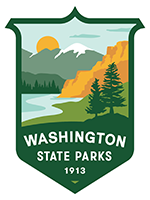We are aware of a text message scam targeting State Parks visitors. It is asking people to share banking information for delinquent payments. This is a scam – we do not ask for payments via text message. Do not click the link, share your information or reply if you receive this text message.
Search results
379 results found
Among Lake Sylvia State Park’s peaceful trails and campsites are nearly hidden stories of ventures to wrest timber and hydroelectricity from the landscape.
Indigenous Lands
Lake Sylvia State Park lies within the traditional territories of Coast Salish Indigenous people whose present-day descendants include members of the Confederated Tribes of the Chehalis Reservation.
Lincoln Rock State Park is a popular recreation area with access to Lake Entiat, the reservoir created by Rocky Reach Dam.
Indigenous Lands
The park lies within the traditional territories of Sahaptian and Interior Salish Indigenous people whose present-day descendants include members of the Confederated Tribes and Bands of the Yakama Nation and the Confederated Tribes of the Colville Reservation. For thousands of years this area has provided habitat for a diverse community of life that forms the basis of their cultures.
Lewis and Clark State Park preserves precious remnants of once-common southwest Washington landscapes along a historic Indigenous travel route.
Indigenous Lands
The park lies within the traditional territories of Coast Salish Indigenous people whose present-day descendants include members of the Cowlitz Indian Tribe and Confederated Tribes of the Chehalis Reservation. For thousands of years this area has provided habitat for a diverse community of life that forms the basis of their cultures.
From park rangers to camp hosts, here’s who can help you enjoy your state park visit
Our in-park staff are excited to welcome you to Washington’s state parks. Whether you’re picnicking for the day, camping for a week or just passing through, there are staff available to help you.
Before you head out, here’s a little bit about the who’s who of staff in our parks.
OLYMPIA — The future trail system at Nisqually State Park is taking shape and the community is invited to join Washington State Parks for a public meeting to get a first-hand look at what’s to come.
Nolte State Park preserves a forest sanctuary surrounding Deep Lake, favored for swimming and picnicking on hot summer days. The lake’s attractively cool waters are due to its 76-foot depth and cold water coming into the lake from Deep Creek, with its headwaters in the 3,000-foot-high foothills of the Cascade Mountains.
The lake has no outlet, as outflow percolates through gravels left as meltwater outwash from the great Ice Age glaciers that filled the Puget Sound lowlands.
CASTLE ROCK – Set to reopen after receiving its first major renovation since it originally opened in 1986, the Mount St. Helens Visitor Center in Castle Rock will begin welcoming visitors on May 31.
2021-22 prices will ensure Sno-Parks continue to operate
OLYMPIA – Oct. 5, 2021 – When Washington Sno-Park permits go on sale Nov. 1, winter recreationists will see a fee increase for the first time since 2009.
Bay View State Park is perched above the waves of Padilla Bay at the western edge of the Skagit Valley. The scenic spot lies within the traditional territories of Coast Salish Indigenous people whose present-day descendants include members of the Samish Indian Nation, Swinomish Indian Tribal Community, Upper Skagit Indian Tribe, Suquamish Tribe and Lummi Nation. For thousands of years the rich estuary and its extensive eelgrass beds have provided habitat for a diverse community of life that forms the basis of their cultures.
Pacific Beach State Park has a long history as a place for travelers to rest as they journey along Washington’s Pacific Ocean coastline.
Indigenous Lands
The park lies within the traditional territories of Coast Salish Indigenous people whose present-day descendants include members of the Quinault Indian Nation and the Confederated Tribes of the Chehalis Reservation.
Ethnographers reported that the mouth of Joe Creek in today’s Pacific Beach State Park served as a “rest stop” for Indigenous people traveling along the coast between trading centers.
